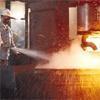Commodity boom turns bust on waning demand
Bloomberg

refid:10682962 ilişkili resim dosyası
Commodity prices in 2008 plunged the most in five decades as demand for energy, metals and grains tumbled in the second half because of the recession.
From July to December, the slumping economy drove crude oil, gasoline, copper, corn, and wheat down from records in the first half. In 2008, the Reuters/Jefferies CRB Index of 19 raw materials fell 36 percent, the most since the gauge debuted in 1956, to 229.54. It rose to a record 473.97 on July 3. On Dec. 5, the measure dropped to the lowest since August 2002.
The worldwide economy crumbled last year. Home prices plummeted, investment banks collapsed and credit froze. U.S. consumer spending plunged, pushing the nation’s automakers to the brink of bankruptcy. Growth in China and other emerging markets withered.
Complete destruction in production and demand
"Macroeconomically, we’re in a free fall," said John Brynjolfsson, the managing director and chief investment officer at hedge fund Armored Wolf in Aliso Viejo, California. "That’s a complete destruction in industrial production and demand, and this is likely to keep pressure on the commodity sector in general."
In 2008, 15 prices dropped in the CRB, led by gasoline and nickel. Only four climbed, paced by cocoa.
"The recession will stretch for at least the next six months," Marc Faber, the managing director of Marc Faber in Hong Kong and publisher of the "Gloom, Boom and Doom Report" said in an interview on Bloomberg Television Dec. 26. "2009 will be a write-off in terms of economic activity."
In 2008, gasoline dropped 59 percent, the most among CRB components. Cocoa climbed 31 percent, the biggest increase. Sugar, gold and hogs were the only other commodities to post gains. Gasoline futures declined to $1.0082 a gallon last year on the New York Mercantile Exchange. The price climbed to a record $3.631 on July 11. The 2008 low was 78.5 cents on Dec. 24.
Crude oil futures tumbled a record 54 percent to $44.60 a barrel last year on the Nymex. The price rose to an all-time high of $147.27 on July 11. On Dec. 19, it touched $32.40, the lowest since February 2004.
Oil may rebound to average $60 in 2009 as the Organization of Petroleum Exporting Countries makes record production cuts to counter the deepest economic slump since World War II.
Copper futures declined 54 percent to $1.41 a pound in 2008 on the Comex division of the Nymex. The price rose to a record $4.2605 on May 5. On Dec. 26, the metal touched $1.255, the lowest since October 2004.
An optimistic view on 2009
"Things are going to be a lot better next year than people think," Lars Steffensen, the founder and managing director of Ebullio Capital Management, a commodity hedge fund based in U.K., said. "The U.S. is going to print the dollar to get out of the recession, and anything tangible, like industrial metals, is going to be worth more."
Cocoa futures in 2008 jumped 30 percent to $2,665 a metric ton on ICE Futures U.S. in New York. A smaller crop in Ivory Coast, the world’s biggest producer, eroded inventories, contributing to a global deficit.
"Cocoa has the best fundamentals of any commodities, except maybe tin," Steffensen said. "They share a low-inventory story, straight deficits and limited ability for production increases, along with supply problems."
Gold futures rose 5.5 percent to $884.30 an ounce last year on the Comex division of the Nymex, marking the eighth-straight annual increase. The metal reached $1,033.90 in March.
Gold as safe haven
Gold may benefit as U.S. government policies result in inflation in the long term, said Chip Hanlon, the president of Delta Global Advisors.
The Federal Reserve "believes it has to prop up the financial system," Hanlon said. "The move toward quantitative easing to fight what they perceive as deflation ultimately will lead to higher rates of inflation."
The U.S. government has pledged more than $8.5 trillion to help ease the credit crisis. The Fed slashed its benchmark interest rate to near zero to help stimulate the economy.
Hog futures climbed 5.2 percent to 60.875 cents a pound last year on the Chicago Mercantile Exchange. The global economic slowdown set the stage for cutbacks in supplies. "We’re going to have 3 percent to 4 percent less pigs next year, and that should be very supportive to higher pork prices," Mark Greenwood, who manages about $1 billion of loans and leases to swine producers for AgStar Financial Services in Mankato, said last month.
















